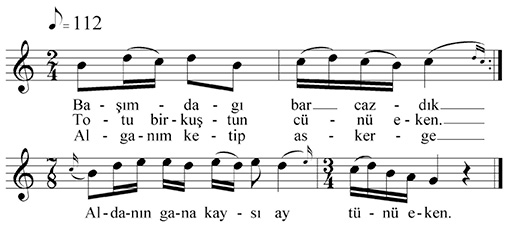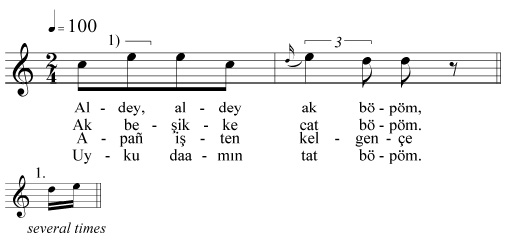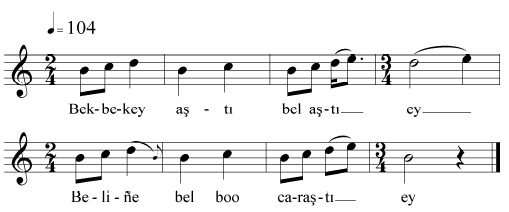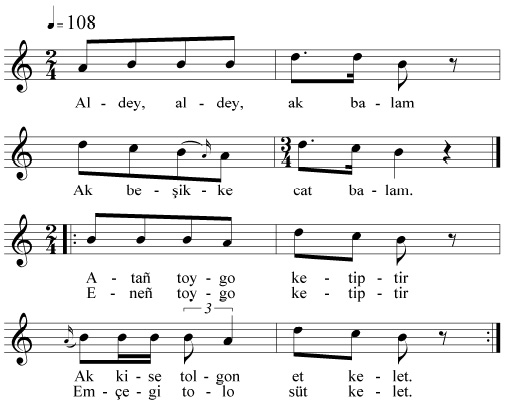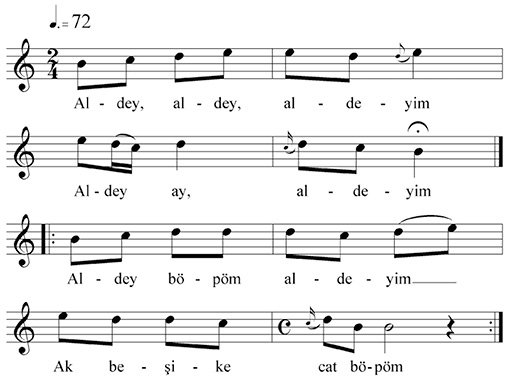- 1. Twin-bar tunes (ex.1-11, №1-58)
- Twin-bar tunes based on the g,-c bichord
- Twin-bar tunes based on rotating motifs
- Twin-bar tunes with descending/hill-shaped lines
- Motifs with a downward leap at the end of the line
- Motivic processes
- 2. Tunes moving on Ionian scales (ex.12-24, №59-164))
- Laments and their relatives
- Two-lined tunes of Major character with higher main cadences and their four-lined relatives
- Four-lined tunes of Major character
- 3. Aeolian tunes (ex.25-36, №165-238)
- Laments and related tunes
- Aeolian tunes with higher main cadence
- Four-lined tunes of Minor character
- Valley-shaped, ascending or undulating first line
- 4. Caramazan religious tunes (ex.37-41, №239-326)
- 5. Tunes of domed structure (ex.42-43, №327-332)
1.2. Twin-bar tunes based on rotating motifs (ex.2-6, №4-33)
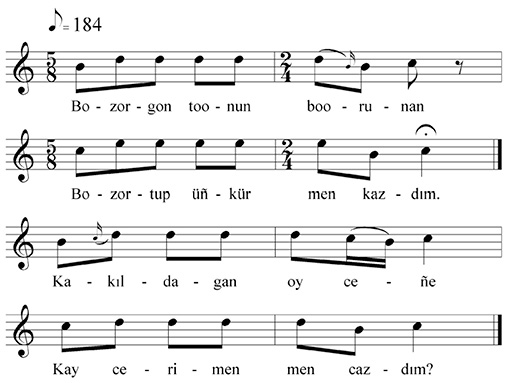


Rotating tunes around the middle notes of tri- and tetrachords are also relatively frequent in the music of several Turkic and non-Turkic peoples. The genres of these tunes are often archaic: in Anatolia or in Hungarian areas the songs of children’s games, rain-making songs, etc. belong here. Compared to the previous group, this form is essentially different from pentatonic music. The intonation of the notes is often uncertain and changes during a performance, thus rotating on Minor thirds may alternate with twirling on Major thirds or with recitation on two notes.
1.2.1. Twin-bar tunes rotating on D-B-C trichord (ex.2a-b, №4-7). The most frequent rotation occurs on the notes of the D-B-C trichord. This kernel is frequent in the recitation of the Manas epic; it is one of the basic motifs of Kyrgyz folk music (ex.2a). Though with a smaller weight, this motif can be found in the music of other Turkic peoples, too, e.g. in the lines of the Kazakh terme tunes. The lines spinning on the D-B-C core often end with a line descending on the E-D-G, or D-B-G, trichord (ex.2b, №5-7). The separate motifs descending on G-E-D-C-G, are to be presented later.
1.2.2. Twin-bar tunes rotating on the D-A-C trichord (№8). This was the only example found of this type.
a)

1.2.3. Twin-bar tunes rotating on the C-D-E trichord (ex.3, №9-11). Rotation on the notes C-D-E-D or E-D-C-D occurs in the twin-bar songs of several Turkic and non-Turkic peoples. In the present collection there are but a few tunes of a single short line each. Beside ex.3 there are hardly any and they are also widely different: the №9 Caramazan tune, №10 rising from the head of the line to the end, and №11 with rotation in line 2 only. Most of these simple tunes not fitting any other category confirm that the rotating motion on E-D-C is fairly atypical of Kyrgyz folk music.
1.2.4. Two-lined Bekbekey tunes (ex.4a, №12-17). The basic form of the Bekbekey tune still of great popularity in Kyrgyzstan moves on the B-C-D trichord, and since its two melody lines can be retraced to the a=B-C D | B C basic motif, its pattern is: a ac || a ac (ex. 4a, №12-17). This explains why it is ranged with the motivic tunes.
1.2.5a. The Phrygian Bekbekey tune and twin-bar tunes rotating on the B-C-D trichord (ex.4b, ex.5, №18-26). The two-lined Bekbekey tune has a Phrygian version closing on the note B (ex. 4b, №18-24), which also displays links with the twin-bar tunes rotating round the central note of the B-C-D trichord (ex.5, №25-26). The importance of this tune scheme in Kyrgyz folk music is proven by its frequency among the lullabies, as seen earlier (№21-22). Let me note here that although the most important trichord of Azeri folk music is this one, the Azeri musical lines are not rotating but descending or hill-shaped. (Sipos 2004)
a)

Two groups of mostly two-lined tunes are to be discussed here, which are performed giusto +>&@ and moving on Phrygian scale. They are ranged here on account of their similarity with the Bekbekey tunes, although they could be categorized with two-lined melodies as well. Most of these tunes move on the E-D-C-B tetrachord, the note F rarely occurring.
1.2.5b. Short sectioned melodies with C or D cadence (ex.6a, №27-29). The tunes of this group resemble the tunes of short lines ranged with the two-core laments, which however close a note deeper, on B instead of C.
1.2.5c. Two short Phrygian lines with E cadence (ex.6b, №30-33). An earmark of the second group is the E closing note of the first line. There are different forms here, but each one can be retraced to the two-lined AB scheme. Both groups display strong resemblance to major Anatolian, Azeri and Turkmen tunes of Phrygian character. There are many lullabies in these groups, which suggests that an old layer of Central Asian Turkic folk music can be discerned here.
a)
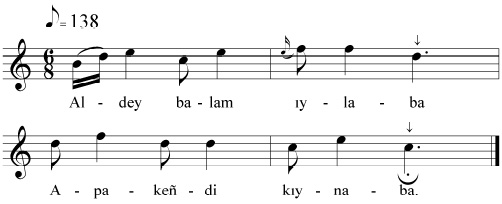
1 ex.2a, Song of the sister-in-law, Sulaymanov Turdugul (1929), Sarıbağış, Kara-Buluñ, 2004; ex.2b, Song to her husband going to war, Asanova Alisa (1929, Birlik), Moñoldor, At-Başı, 2004
2 ex.3, Lullaby, Aşırbekova Kunduz (1952, Toktogul), Beren, Kalba, 2004
3 ex.4a, Bekbekey (watchman’s cry), Satindiyeva Seydekan (1944, Ceti-Ögüz, Tösör), Buğu, Tosor, 2002; ex.4b, Bekbekey (watchman’s cry), Cakıpova Toktobübü (1938, Can-Bulak), Moñoldor, Çoko, 2004
4 ex.5, Lullaby, Tentimişova Ayşa (1932, Ceti Ögüz), Döölöş, Kara-Koyun, 2004
5 ex.6a, Lullaby, Kopoyeva Iriskan (1939, Kara-Suu), Sarıbağış, Kara-Buluñ, 2004; ex.6b, Lullaby (beşik ırı), Otorbek kızı Azimkan (1949, Köpürö Bazar), Kuşçu, Taldı-Bulak, 2004

